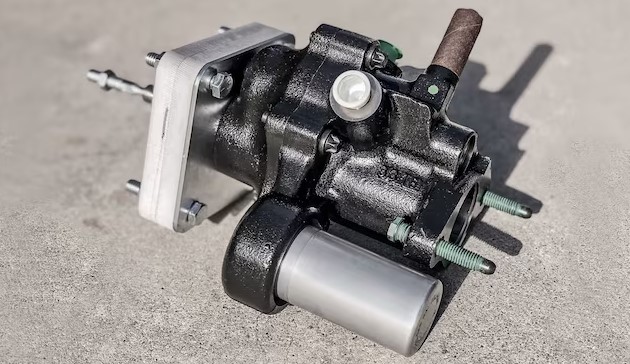
 Hydroboost brake systems are a popular choice for many vehicles, as they provide a more efficient and powerful braking system than traditional vacuum-based systems. However, if your hydroboost brake pedal goes to the floor, it can be a sign of a serious issue. In this article, we will discuss the common causes of this issue and how to troubleshoot it. We will also provide some tips on how to prevent this issue from occurring in the future.
Hydroboost brake systems are a popular choice for many vehicles, as they provide a more efficient and powerful braking system than traditional vacuum-based systems. However, if your hydroboost brake pedal goes to the floor, it can be a sign of a serious issue. In this article, we will discuss the common causes of this issue and how to troubleshoot it. We will also provide some tips on how to prevent this issue from occurring in the future.
How to Diagnose a Hydroboost Brake System When the Pedal Goes to the Floor
Diagnosing a hydroboost brake system when the pedal goes to the floor can be a difficult task. In order to properly diagnose the issue, it is important to understand the components of the system and how they work together.
The hydroboost brake system is composed of several components, including the master cylinder, the hydroboost unit, the power steering pump, and the brake lines. The master cylinder is responsible for converting the force of the driver’s foot on the brake pedal into hydraulic pressure. This pressure is then sent to the hydroboost unit, which amplifies the pressure and sends it to the brake calipers. The power steering pump is responsible for providing the hydraulic fluid necessary for the system to operate. Finally, the brake lines connect the components of the system and allow the hydraulic pressure to travel from the master cylinder to the calipers.
When diagnosing a hydroboost brake system, it is important to check all of these components for any signs of damage or wear. If any of the components are damaged or worn, they should be replaced. Additionally, it is important to check the brake lines for any signs of leakage or blockage. If any of the lines are blocked or leaking, they should be replaced.
Once all of the components have been checked and replaced if necessary, it is important to check the system for any air bubbles. Air bubbles can cause the pedal to go to the floor, as they reduce the amount of hydraulic pressure that is sent to the calipers. To check for air bubbles, the system should be bled using a vacuum bleeder.
Finally, it is important to check the power steering pump for any signs of wear or damage. If the pump is not functioning properly, it will not be able to provide the necessary hydraulic fluid for the system to operate.
By following these steps, it is possible to diagnose a hydroboost brake system when the pedal goes to the floor. It is important to remember that any components that are damaged or worn should be replaced, and that the system should be bled to remove any air bubbles. Additionally, the power steering pump should be checked for any signs of wear or damage. By following these steps, it is possible to diagnose and repair a hydroboost brake system.
Common Causes of a Hydroboost Brake Pedal Going to the Floor and How to Fix Them
Hydroboost brakes are a type of power brake system that uses hydraulic pressure from the power steering pump to assist in braking. When the brake pedal goes to the floor, it can be a sign of a serious problem. Common causes of a hydroboost brake pedal going to the floor include a low brake fluid level, a faulty master cylinder, a faulty power steering pump, a faulty hydroboost unit, or a faulty brake booster.
Low Brake Fluid Level
If the brake fluid level is low, the brake pedal will go to the floor. To fix this, check the brake fluid level and top it off if necessary.
Faulty Master Cylinder
A faulty master cylinder can cause the brake pedal to go to the floor. To fix this, the master cylinder must be replaced.
Faulty Power Steering Pump
If the power steering pump is not working properly, it can cause the brake pedal to go to the floor. To fix this, the power steering pump must be replaced.
Faulty Hydroboost Unit
If the hydroboost unit is not working properly, it can cause the brake pedal to go to the floor. To fix this, the hydroboost unit must be replaced.
Faulty Brake Booster
A faulty brake booster can cause the brake pedal to go to the floor. To fix this, the brake booster must be replaced.
In conclusion, a hydroboost brake pedal going to the floor can be caused by a low brake fluid level, a faulty master cylinder, a faulty power steering pump, a faulty hydroboost unit, or a faulty brake booster. To fix these issues, the faulty component must be replaced.
Conclusion
In conclusion, troubleshooting an issue with a Hydroboost brake system can be a difficult task. However, with the right knowledge and tools, it is possible to diagnose and repair the issue. The most common cause of a Hydroboost brake pedal going to the floor is a lack of hydraulic pressure. This can be caused by a faulty master cylinder, a leak in the system, or a faulty Hydroboost unit. By checking the system for leaks, replacing the master cylinder, and testing the Hydroboost unit, the issue can be resolved.